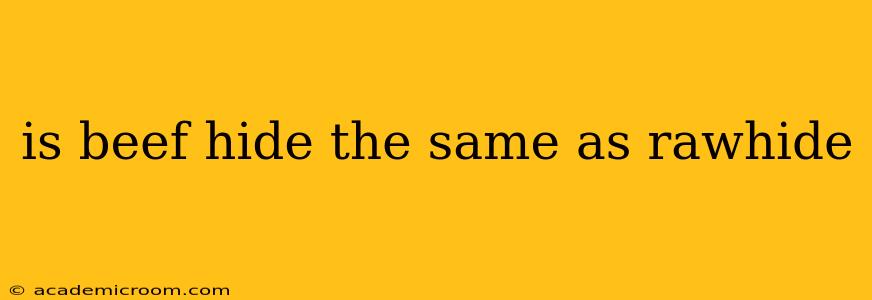Many pet owners wonder about the difference between beef hide and rawhide chews. While closely related, there are crucial distinctions that impact your pet's safety and the chew's longevity. This article clarifies the similarities and differences, addressing common questions to help you make informed choices for your furry friend.
What is Beef Hide?
Beef hide, simply put, is the raw skin of a cow. It's the outermost layer, encompassing the muscles and fat beneath. Before becoming a chew toy, it undergoes various processing methods, which significantly affect its final form and properties. This processing can range from minimal treatment to extensive preparation, resulting in widely varying chew types.
What is Rawhide?
Rawhide, despite its name, is rarely truly "raw." It typically refers to beef hide that's been processed through a series of steps to preserve it. This often involves cleaning, curing (sometimes with preservatives), and potentially splitting the hide into thinner layers. This processing changes the texture and makes it more durable—or so it seems.
Are Beef Hide and Rawhide the Same? The Key Differences
While both originate from beef hide, the processing determines the key differences:
-
Processing Methods: Beef hide can undergo various levels of processing, from minimal treatment to the extensive procedures involved in making commercial rawhide chews. Rawhide often undergoes tanning or other chemical treatments to preserve it, increase durability, and change its texture, while some minimally-processed beef hides may only be cleaned and dried.
-
Texture and Durability: Rawhide tends to be more densely compressed and durable than minimally processed beef hide, which might be softer and more easily torn. However, this increased durability in rawhide comes at a cost – often at the expense of natural ingredients.
-
Safety Concerns: This is where the biggest difference lies. Rawhide chews have been linked to potential choking hazards, digestive issues (like blockages), and exposure to harmful chemicals from the processing. Minimally processed beef hides may pose fewer risks but still carry a risk of bacterial contamination unless properly sourced and prepared.
What are the Potential Dangers of Rawhide Chews?
Many pet owners are concerned about the potential dangers of rawhide chews, and these concerns are valid. Here are some key risks:
Choking Hazards: Large pieces can pose a choking risk, particularly for smaller dogs. Even small pieces can swell when ingested, creating further blockage.
Digestive Issues: Rawhide can be difficult to digest, potentially leading to constipation or intestinal blockages. The hardness and fibrous nature of the product contribute to this risk.
Chemical Exposure: Some rawhide chews may contain preservatives, bleaching agents, or other chemicals used in the processing. These chemicals can be harmful if ingested.
Bacterial Contamination: Rawhide can harbor harmful bacteria, especially if it isn't sourced and processed properly.
Are There Safer Alternatives to Rawhide?
Fortunately, yes! Many safer chew options are available for your pet, including:
- Beef Bullies (or pizzles): These are dried beef penises and tend to be a more digestible and less processed option.
- Dental chews: These come in various materials and are designed to promote dental hygiene.
- Natural chews like yak cheese or antlers: These are often a longer-lasting and more digestible option than rawhide.
- Frozen fruits and vegetables: Offer a healthy and refreshing alternative to traditional chews.
Always supervise your pet while they are chewing on any product.
Conclusion
While beef hide and rawhide are related, the extent of processing significantly impacts safety and digestibility. Understanding these differences helps you make informed choices for your pet's well-being. Always prioritize safe, high-quality chews and monitor your pet's chewing habits closely. Choosing safer alternatives can provide the same satisfaction without the potential health risks associated with heavily processed rawhide.
